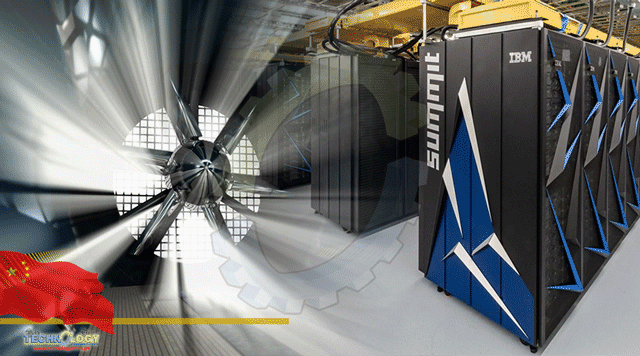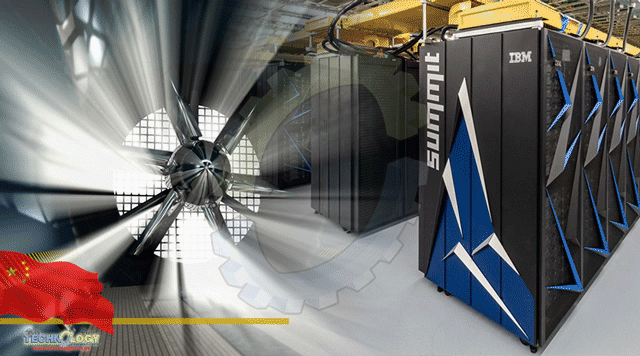Power-Hungry Wind Tunnels May Be Indicator That CFD Software Running On Supercomputers May Not Serve Purpose Of Designing Aircraft By Chinese.

The West has been very concerned about its technologies being used by Beijing’s security apparatus for the surveillance of Chinese citizens. While the Trump administration took positive steps to curtail the export of Western technologies to China for fear of aiding its competitiveness, we still need to assess China’s technological capabilities, lest we should lose sight of the bigger picture.
China’s supercomputers
Despite U.S. concerns about China’s technological advancement, the authoritarian regime still has a long way to go to catch up with the West. As an example, 227 Of China’s Supercomputers Were Ranked Among The World’s Fastest 500 In 2020. Its Sunway Taihulight And Tianhe-2 Are Ranked The World’s Number Three And Four, Respectively. This article is meant to argue that the superficial phenomenon could be misleading.
Building supercomputers is no longer out of reach for ordinary researchers with ample funding. They can simply stack up powerful commercially available processors and fast memory cards to integrate such an energy-hungry beast. Though China claims Sunway TaihuLight is comprised of indigenous processors (Sunway SW26010), it’s nevertheless based on the DEC Alpha architecture from the U.S.
Tianhe-2 uses nothing but Intel processors. Moreover, both systems’ operating system is Linux. Compilers on all Chinese supercomputers — the software that translates and optimizes human logic instructions into machine-readable format — all come from U.S.-invented GNU or Intel. That means the foundation of China’s supercomputers is based on Western technologies, not their own innovative research. Most importantly, it’s the application software that determines the utility of parallel supercomputers. More often than not, such software has to be crafted carefully to make full use of the underlying parallel architecture.
From publicly available information, it seems both Chinese supercomputers mentioned above have mostly non-military applications, such as meteorological and chemical reaction modeling; however, if we look at the accuracy of China’s weather forecasts, one can reasonably doubt how innovative and proficient the China Meteorological Administration (CMA) has been in the development of weather models and software.
In fact, most of CMA’s weather applications are still being executed on older IBM Flex networked servers. It’s true that CMA also has two indigenous Sugon TC4600 supercomputers built upon Intel technologies, though it remains dubious how much of the parallelism potential has been exploited in the machines. For operating systems, the system software that manages computer hardware, software resources, and provides common services for computer programs, China lags far behind the U.S.
Security and the risk of backdoors in devices from Western vendors are some of the main motivations for China to develop its own operating system. The results have been dismal at best. For example, China embarked on the ambition to develop its indigenous versions, such as China Operating System (COS) and Unity Operating System (UOS), both of which are based on Linux-variant architecture. While UOS claims to support China’s own CPUs, COS has been accused of copying from Android. It remains to be seen if any of China’s indigenous operating systems can take off.
The role of supercomputers in aircraft design
Another important application area for supercomputers is in aerospace. China in the past has been known to import, legally or otherwise, computational fluid dynamics (CFD) software from various Western institutions, including NASA. However, the fact that China’s aircraft development still heavily relies on very expensive and Power-Hungry Wind Tunnels May Be An Indicator That The CFD Software Running On Supercomputers May Not Serve The Purpose Of Designing Aircraft By The Chinese.
Huawei delivered its first supercomputer using its own Kunpeng 920 processor to the AVIC Aerodynamics Research Institute (AVIC ARI) in October 2019. The AVICARI, established in 1955, is China’s preeminent research arm in aerodynamics and has a campus in Shenyang (626 Institute) and another in Harbin (627 Institute).
Wind tunnel used in aircraft design
AVICARI has 13 wind tunnels altogether and support the design and development of J-11 (Russian Su-27SK), J-15 (Su-27K), J-16 (Su-30MKK), and J-31 aircraft (China’s second stealth fighter), as well as various missiles by the Shenyang Aircraft Corporation, which is under the Aviation Industry Corporation of China (AVIC). The peak performance of Huawei’s supercomputer is 1.3 PFLOPS, about 100 times slower than the world’s fastest supercomputer — IBM AC922. It’s unclear what applications AVIC ARI runs on the machine, though given its status as a new installation, its full potential may have yet to be exploited.
Located in Mianyang, Sichuan, the China Aerodynamics Research and Development Center (CARDC) has been under the PLA’s Strategic Support Force (PLA Unit 63820) since 2016. With 2,000 researchers, it has four wind tunnels and a supercomputer to aid aircraft design. CARDC is believed to have supported the Chengdu Aircraft Industry Group’s development of J-10 and J-20.
It’s unclear what CFD software both CARDC and AVICARI employ to design aircraft. The few papers published by their researchers in the public domain do not seem to be of superior quality. In the early days of aviation, wind tunnels were used to see how new aircraft designs would fly. Nowadays, they are more likely to be used for verification and certification purposes.
Aerodynamics is an engineering problem that has been solved by the development of high performance computers able to perform complex CFD simulations. This software enables engineers to show how “flows” of wind will dynamically interact with 3D digital models. Wind tunnels nowadays are used to verify computer simulations at different stages of aircraft R&D. Therefore, CFD is only as good as the people’s knowledge on the physics of fluid dynamics and related aircraft design issues.
For the J-20 development, we still do not know how well it performs. Intellectual property theft from the West is one possibility, though outside help seems likely as well. Given the fact that former DLR employees from Germany have helped China in their LM-5 rocket engine development, it’s highly likely that China has sought external help to design the J-20. Through this model, some advanced technical information regarding stealth fighters may have been transferred similarly.
Peeking into the energy consumption
In any case, to peek into exactly how China is using their wind tunnels and/or supercomputers to aid military aircraft design, one could dig into the electricity bills of the institutes mentioned above. Dependent upon what “flying on the ground” tests are conducted, a wind tunnel could consume up to 250 megawatts of electricity per hour. Supercomputers also consume a lot of energy, but it’s nowhere near that of the wind tunnel on the per hour basis.
For example, China’s Tianhe-2 could consume up to 18 megawatts per hour, enough to support a small city of 35,000 residents. But the way both tools are used is different. Supercomputers tend to stay on all the time and wind tunnels are powered up only when they are needed for a short period of time. Examining the energy bills could yield insight into how and when supercomputers and wind tunnels are being used in China’s aircraft design. Such insight could help the outside world understand China’s technological prowess.
U.S. assistance to help China develop aircraft avionics
Many U.S. aerospace companies, some of them global giants, have established joint ventures (JV) with China under the auspices of the Commercial Aircraft Corporation of China (COMAC) C919 commercial aircraft program. For example, Honeywell partnered with COMAC and transferred technologies ranging from flight management systems, cockpit systems and displays, turbine engines, inertial navigation systems, and air data sensors.
Rockwell Collins, another U.S. aerospace giant, established a joint venture with the Aviation Industry Corporation of China (AVIC), a Chinese state-owned aerospace and defense conglomerate. The purpose of the joint venture is for Rockwell to teach AVIC systems engineering, software development, avionics testing, systems integration, and integrated surveillance. Another of Rockwell’s JVs in China is for transferring the expertise of how to design and manufacture full-motion flight simulators to the Chinese. The simulators can be used to train both commercial and military pilots.
Rockwell has been working with the Chinese aviation industry for more than 30 years. The company’s electronics are on many airplanes manufactured in China, including Shaanxi Y-8 (运-8) and Harbin Y-12 (运-12) military transport aircraft, both of which can be used to transport troops and weapon systems. Some airplanes of both models have been outfitted with electronic surveillance measurement equipment to spy on China’s neighbors, such as Taiwan and Japan. General Electric also established a joint venture with AVIC to teach the Chinese how to build avionics, displays, flight recorders, and flight management systems, among others technologies, under the COMAC C919 program.
Some Western aerospace companies have teamed up with the China Electronics Technology Group Corporation (CETC), a state-owned enterprise administered by the State Council. Constituted by 47 institutes, CETC has over half a million scientists and engineers tasked to develop China’s aerospace and defense capabilities. With assistance from the West, CETC and its subsidiaries have participated in many Chinese aircraft programs, including for fixed wing and rotary wing aircraft, some of them military.
Most of the above-mentioned technologies are dual use in nature. Since everything is under state control in China, it is a foregone conclusion that there is no firewall between civilian and military technological programs to prevent dual use technologies from migrating to the military. This is a dangerous trend, especially since the U.S. aerospace industry has done so much business with China that Beijing can now have a say in merger and acquisition activities in the industry.
In 2017, United Technologies Corp.’s takeover of Rockwell Collins could not be completed without the approval of Chinese regulators. Why so many advanced aerospace technologies are allowed to be transferred to China is beyond the imagination of any sensible observer. The U.S. government must enact a functional legal framework to stem the outflow of such transfers before it’s too late.
This news was originally published at Taiwan News.
